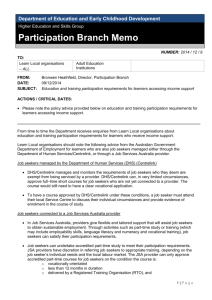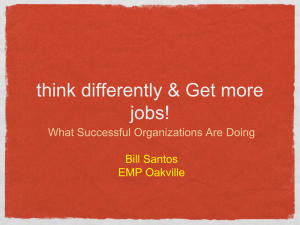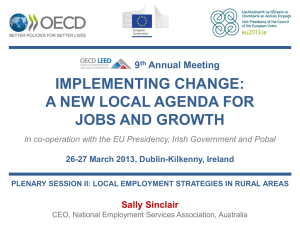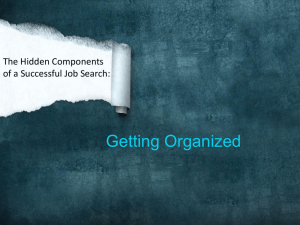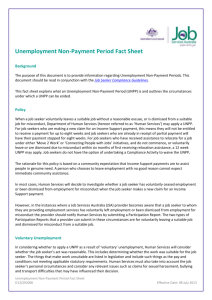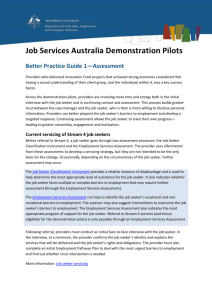DOCX file of Better Practice Guide 3: Job Seeker Contact
advertisement
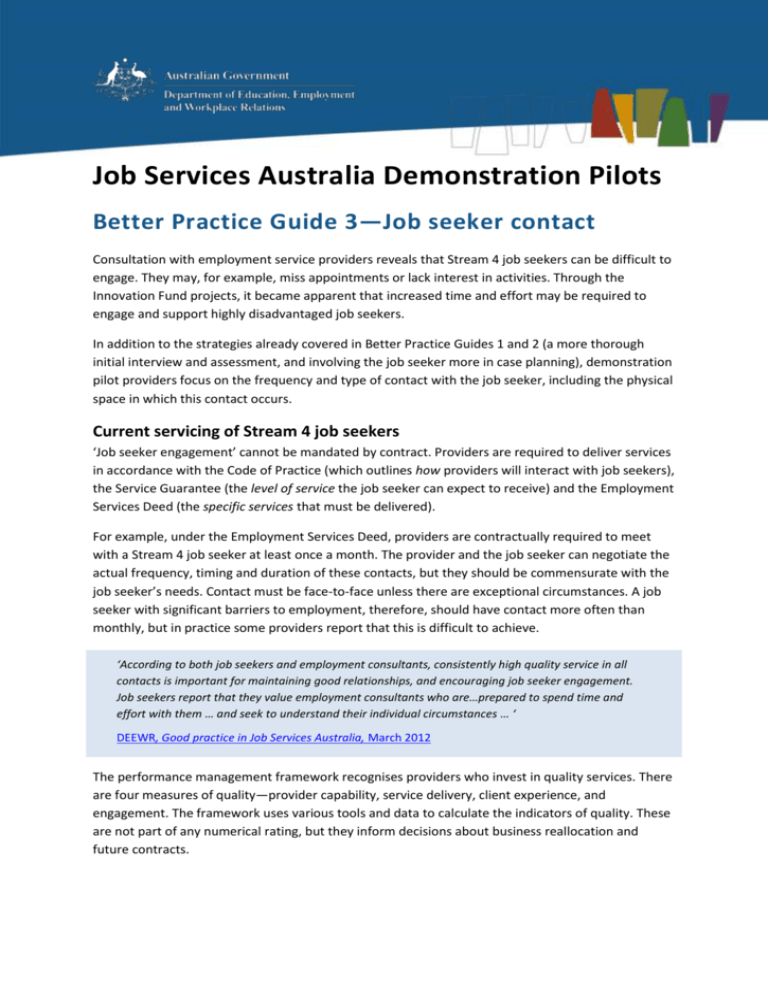
Job Services Australia Demonstration Pilots Better Practice Guide 3—Job seeker contact Consultation with employment service providers reveals that Stream 4 job seekers can be difficult to engage. They may, for example, miss appointments or lack interest in activities. Through the Innovation Fund projects, it became apparent that increased time and effort may be required to engage and support highly disadvantaged job seekers. In addition to the strategies already covered in Better Practice Guides 1 and 2 (a more thorough initial interview and assessment, and involving the job seeker more in case planning), demonstration pilot providers focus on the frequency and type of contact with the job seeker, including the physical space in which this contact occurs. Current servicing of Stream 4 job seekers ‘Job seeker engagement’ cannot be mandated by contract. Providers are required to deliver services in accordance with the Code of Practice (which outlines how providers will interact with job seekers), the Service Guarantee (the level of service the job seeker can expect to receive) and the Employment Services Deed (the specific services that must be delivered). For example, under the Employment Services Deed, providers are contractually required to meet with a Stream 4 job seeker at least once a month. The provider and the job seeker can negotiate the actual frequency, timing and duration of these contacts, but they should be commensurate with the job seeker’s needs. Contact must be face-to-face unless there are exceptional circumstances. A job seeker with significant barriers to employment, therefore, should have contact more often than monthly, but in practice some providers report that this is difficult to achieve. ‘According to both job seekers and employment consultants, consistently high quality service in all contacts is important for maintaining good relationships, and encouraging job seeker engagement. Job seekers report that they value employment consultants who are…prepared to spend time and effort with them … and seek to understand their individual circumstances … ‘ DEEWR, Good practice in Job Services Australia, March 2012 The performance management framework recognises providers who invest in quality services. There are four measures of quality—provider capability, service delivery, client experience, and engagement. The framework uses various tools and data to calculate the indicators of quality. These are not part of any numerical rating, but they inform decisions about business reallocation and future contracts. Among other things, the measures indicate whether the job seeker felt that the help they received was suited to their circumstances and whether staff treated them with respect. The measures also consider contacts between job seekers and providers, and the job seeker’s engagement in activities. Within this performance management and contractual framework, providers have a lot of flexibility in how they deliver services. High-performing providers emphasise the importance of building rapport with job seekers and invest time in this process. They pay attention to personal relationships and the physical comfort of the job seeker. What are the demonstration pilots trialling? A common practice among demonstration pilot providers is to increase the frequency of contact with Stream 4 job seekers to fortnightly, weekly, or even twice weekly. They also ensure that each contact is purposeful—it is used to discuss the job seeker’s progress against their case plan, to celebrate their achievements, to identify and tackle any new barriers, and to deliver specific interventions such as courses and activities. By seeing Stream 4 job seekers at weekly appointments, ASK Employment has developed a more accurate picture of their circumstances. ‘Through the increased contact with job seekers participating in the pilot (on-site and through a structured course), we realised that one of the job seekers was under the influence of narcotics. When the job seeker had attended their initial appointment with us, they had advised that they were no longer a user, but after a couple of weeks of at least two days per week contact, it became evident that this was not the case. The job seeker admitted that if they had not been participating in the project … they would not have disclosed their narcotics use as they were able to hide this information while only attending monthly appointments.’ As a result of the increased contacts, the job seeker was referred to counselling and was given support to move into accommodation that would promote a more positive lifestyle. ‘An extremely positive outcome from increased engagement and specialist counselling intervention.’ ASK Employment–Proactive Engagement MAX Employment (Ipswich pilot) reports that many young Stream 4 job seekers have no routine or structure in their home life. Frequent contact with the provider can create this structure. The provider notes that a break in the contact routine can interrupt the job seeker’s momentum, and they can quickly fall into previous habits. Another common practice among demonstration pilots is for case managers to spend more time with Stream 4 job seekers at each visit than in ‘standard service arrangements’. To make this possible, providers may reduce a manager’s caseload, or share the load among a case management team. When asked how long the assessment process for pilot job seekers took, the Service to Youth Council Clinical Case manager replied ‘As long as needed, sometimes one session [about 1 hour] and other times three or even four. It depends on the job seeker.’ Service to Youth—LAUNCH project See also Better Practice Guide 4—Case management Pilot providers generally report that job seekers respond well to additional time spent with their case manager or case management team. They often welcome the interest in their lives and are pleased that the focus extends beyond employment issues. They interpret this broad interest as a practical demonstration of care toward them as individuals and this leads to increased motivation. A number of providers also work with job seekers in a less formal environment, using either an adapted space within the provider’s office or a venue outside the office. ‘Stream 4 job seekers can associate the public Job Services Australia office with stigma and formality, and this can affect their willingness to disclose and to participate in activities designed to remove their barriers.’ ORS Employment—HOPE project Providers who deliver services off-site comment that job seekers often appreciate the change in environment as interesting and new. Providers encourage the job seeker to attend off-site by providing transport or reimbursing transport costs. Other providers adapt their existing premises to create a more comfortable environment for job seekers. For example, ORS Employment (HOPE project) delivers courses on-site alongside existing contact appointments to encourage attendance. Pilot activities are delivered in a dedicated room. Job seekers are encouraged to personalise this space, for example by hanging posters on the wall. The room includes a chill-out area. Early learnings While this result may not be attributable to any one strategy or approach, attendance rates (as an indicator of job seeker engagement) are strong across the demonstration pilots. Notable results are highlighted below. At the interim evaluation, the Service to Youth Council - Launch reported 81 per cent attendance at clinical case management appointments—that is, weekly meetings with a human services professional, designed to identify and deal with personal barriers. This figure is significant because these appointments are voluntary and there are no penalties for non-attendance. In addition, the provider reports 78 per cent attendance at employment consultant appointments, which deal purely with employment matters; this compares with a baseline attendance rate of 55.5 per cent by Stream 4 job seekers who are not taking part in the pilot. At the interim evaluation stage, BoysTown had established and maintained an attendance rate of 84 per cent in its program. Implications for 2015 Initial results from the demonstration pilots suggest that monthly contact is likely to be insufficient for Stream 4 job seekers. There can be benefits in more frequent contact, provided it is purposeful. Pilot providers regularly discuss and review the job seeker’s progress against their goals, celebrate the job seeker’s achievements, and identify and address emerging issues. These actions contribute to meaningful contact with the job seeker, resulting in stronger engagement. These Better Practice Guides reflect the processes and strategies providers have used to deliver services under the Job Service Australia Demonstration Pilots. They are not intended to offer evidence about the performance of the pilots. The Guides disaggregate pilot services into distinct service elements to aid in presentation and reference only. Interactions occur between all aspects of services and all areas should be considered when looking at the provision of good practice services to highly disadvantaged job seekers.
